Qualitative Investigation of Damage Initiation at Meso-Scale in Spheroidized C45EC Steels by Using Crystal Plasticity-Based Numerical Simulations
Abstract
1. Introduction
2. Methodology and Numerical Simulation Modelling
2.1. Experimental Data
2.2. Numerical Model Definition
2.3. Numerical Model Definition
- = equivalent plastic strain of the whole RVE
- = equivalent plastic strain of an element
- = volume of an ith element in the RVE
- n = total number of elements in the RVE
- = equivalent stress of the whole RVE
- = equivalent stress of an element.
3. Results and Discussion
3.1. Global Results
3.2. Local Results during Mechanical Deformation of S-83
- Zone A is defined to study the local stress, strain, and damage behavior of similarly orientated adjacent ferrite grain without any cementite particle inclusion.
- To analyze the effect of the different orientations of one ferrite grain on its neighboring grain, zone B is marked on three local maps in Figure 5. This zone does not contain cementite particles; therefore, the significant behavior difference is influenced by the orientation of the ferrite grains.
- The different orientations and the clustered cementite particles are highlighted in zone C, which is of utmost importance.
3.3. Local Results during Mechanical Deformation of S-97
4. Discussion
- The grain boundary is considered ideally akin to the grains, and its intrinsic effect has been ignored.
- The absence of a definition of ferrite–cementite interface-specific effects and properties.
5. Conclusions
- It is shown that the presented methodology and numerical simulation model can be used to study the global flow trends that match, with greater than 99% and 97% accuracy between the simulation and experimental results for the S-83 and S-97 sa mples, respectively, achieved for plastic flow region in zone B. Furthermore, the minimum error suggests that the local results presented in this study can be attributed to the actual material’s behavior.
- The S-83 sample with cementite particle clusters has shown multiple damage incidents earlier than the S-97 sample, having fine and homogeneously distributed cementite particles. In addition, the first damage incident in the same material is delayed until 2% global strain only because of the well-designed heat-treatment process.
- Contrary to the engineering (macroscopic) scale, the crystal plasticity-based simulation methodology can help us to understand the texture development and evolution during mechanical deformation. The crystallographic orientation of neighboring grains influences the grain orientation during thermo-mechanical deformation, changing the material behavior at the micro-level, and consequently at the component scale.
- Within the presently taken 2D RVEs under monotonic tensile load, the damage initiation occurs at the ferrite–cementite interface and propagates at ±45° in relation to the direction of the applied load.
Author Contributions
Funding
Institutional Review Board Statement
Informed Consent Statement
Data Availability Statement
Acknowledgments
Conflicts of Interest
References
- Rana, R.; Sing, S.B. Automotive Steels, Design, Metallurgy, Processing and Applications; Woodhead Publishing: Cambridgeshire, UK, 2017. [Google Scholar]
- Pan, H. Development and Application of Lightweight High-strength Metal Materials. MATEC Web Conf. 2018, 207, 03010. [Google Scholar] [CrossRef]
- Wilhelm, M. Materials used in automobile manufacture—current state and perspectives. J. Phys. 1993, 3, 7–31. [Google Scholar] [CrossRef][Green Version]
- Wong, S.L.; Madivala, M.; Prahl, U.; Roters, F.; Raabe, D. A crystal plasticity model for twinning- and transformation-induced plasticity. Acta Mater. 2016, 118, 140–151. [Google Scholar] [CrossRef]
- Prasad, C.; Bhuyan, P.; Kaithwas, C.; Saha, R.; Mandal, S. Microstructure engineering by dispersing nano-spheroid cementite in ultrafine-grained ferrite and its implications on strength-ductility relationship in high carbon steel. Mater. Des. 2018, 139, 324–335. [Google Scholar] [CrossRef]
- Harisha, S.R.; Sharma, S.; Kini, U.A.; Shankar, M.C.G. Study on Spheroidization and Related Heat Treatments of Medium Carbon Alloy Steels. MATEC Web Conf. 2018, 144, 2008. [Google Scholar] [CrossRef]
- Joo, H.S.; Hwang, S.K.; Baek, H.M.; Im, Y.-T.; Son, I.-H.; Bae, C.M. The effect of a non-circular drawing sequence on spheroidization of medium carbon steel wires. J. Mater. Process. Technol. 2015, 216, 348–356. [Google Scholar] [CrossRef]
- Umar, M.; Qayyum, F.; Farooq, M.U.; Khan, L.A.; Guk, S.; Prahl, U. Investigating the Effect of Cementite Particle Size and Distribution on Local Stress and Strain Evolution in Spheroidized Medium Carbon Steels using Crystal Plasticity-Based Numerical Simulations. Steel Res. Int. 2021, 92, 1–13. [Google Scholar] [CrossRef]
- Song, W.; Choi, P.-P.; Inden, G.; Prahl, U.; Raabe, D.; Bleck, W. On the Spheroidized Carbide Dissolution and Elemental Partitioning in High Carbon Bearing Steel 100Cr6. Met. Mater. Trans. A 2013, 45, 595–606. [Google Scholar] [CrossRef]
- Lv, Z.; Wang, B.; Wang, Z.; Sun, S.; Fu, W. Effect of cyclic heat treatments on spheroidizing behavior of cementite in high carbon steel. Mater. Sci. Eng. A 2013, 574, 143–148. [Google Scholar] [CrossRef]
- Amos, P.K.; Bhattacharya, A.; Nestler, B.; Ankit, K. Mechanisms of pearlite spheroidization: Insights from 3D phase-field simulations. Acta Mater. 2018, 161, 400–411. [Google Scholar] [CrossRef]
- Guk, S.; Augenstein, E.; Zapara, M.; Kawalla, R.; Prahl, U. Effect of Spheroidization Annealing on Pearlite Banding. Mater. Sci. Forum 2019, 949, 40–47. [Google Scholar] [CrossRef]
- Tasan, C.; Diehl, M.; Yan, D.; Bechtold, M.; Roters, F.; Schemmann, L.; Zheng, C.; Peranio, N.; Ponge, D.; Koyama, M.; et al. An Overview of Dual-Phase Steels: Advances in Microstructure-Oriented Processing and Micromechanically Guided Design. Annu. Rev. Mater. Res. 2015, 45, 391–431. [Google Scholar] [CrossRef]
- Mohammed, B.; Park, T.; Pourboghrat, F.; Hu, J.; Esmaeilpour, R.; Abu-Farha, F. Multiscale crystal plasticity modeling of multiphase advanced high strength steel. Int. J. Solids Struct. 2018, 151, 57–75. [Google Scholar] [CrossRef]
- Ghadbeigi, H.; Pinna, C.; Celotto, S. Failure mechanisms in DP600 steel: Initiation, evolution and fracture. Mater. Sci. Eng. A 2013, 588, 420–431. [Google Scholar] [CrossRef]
- Li, Z.-X.; Li, C.-S.; Zhang, J.; Qiao, B.; Li, Z.-Z. Effects of Annealing on Carbides Size and Distribution and Cold Formability of 1.0C-1.5Cr Bearing Steel. Metall. Mater. Trans. A Phys. 2015, 46, 3220–3231. [Google Scholar] [CrossRef]
- Storojeva, L.; Ponge, D.; Kaspar, R.; Raabe, D. Development of microstructure and texture of medium carbon steel during heavy warm deformation. Acta Mater. 2004, 52, 2209–2220. [Google Scholar] [CrossRef]
- Saha, A.; Mondal, D.K.; Maity, J. Effect of cyclic heat treatment on microstructure and mechanical properties of 0.6wt% carbon steel. Mater. Sci. Eng. A 2010, 527, 4001–4007. [Google Scholar] [CrossRef]
- Matusiewicz, P.; Augustyn-Nadzieja, J.; Czarski, A.; Skowronek, T. Kinetics of pearlite spheroidization. Arch. Metall. Mater. 2017, 62, 231–234. [Google Scholar] [CrossRef]
- Tasan, C.; Hoefnagels, J.; Diehl, M.; Yan, D.; Roters, F.; Raabe, D. Strain localization and damage in dual phase steels investigated by coupled in-situ deformation experiments and crystal plasticity simulations. Int. J. Plast. 2014, 63, 198–210. [Google Scholar] [CrossRef]
- Maruschak, P.O.; Panin, S.V.; Stachowicz, F.; Danyliuk, I.M.; Vlasov, I.; Bishchak, R.T. Structural levels of fatigue failure and damage estimation in 17Mn1Si steel on the basis of a multilevel approach of physical mesomechanics. Acta Mech. 2015, 227, 151–157. [Google Scholar] [CrossRef]
- Qayyum, F.; Guk, S.; Kawalla, R.; Prahl, U. On Attempting to Create a Virtual Laboratory for Application-Oriented Microstructural Optimization of Multi-Phase Materials. Appl. Sci. 2021, 11, 1506. [Google Scholar] [CrossRef]
- Diehl, M.; An, D.; Shanthraj, P.; Zaefferer, S.; Roters, F.; Raabe, D. Crystal plasticity study on stress and strain partitioning in a measured 3D dual phase steel microstructure. Phys. Mesomech. 2017, 20, 311–323. [Google Scholar] [CrossRef]
- Umar, M.; Qayyum, F.; Farooq, M.U.; Khan, L.A.; Guk, S.; Prahl, U. Analyzing the cementite particle size and distribution in heterogeneous microstructure of C45EC steel using crystal plasticity based DAMASK code. In Proceedings of the 2021 International Bhurban Conference on Applied Sciences and Technologies (IBCAST), Islamabad, Pakistan, 12–16 January 2021; pp. 15–20. [Google Scholar] [CrossRef]
- Qayyum, F.; Umar, M.; Guk, S.; Schmidtchen, M.; Kawalla, R.; Prahl, U. Effect of the 3rd dimension within the representative volume element (Rve) on damage initiation and propagation during full-phase numerical simulations of single and multi-phase steels. Materials 2020, 14, 42. [Google Scholar] [CrossRef]
- Qayyum, F.; Chaudhry, A.A.; Guk, S.; Schmidtchen, M.; Kawalla, R.; Prahl, U. Effect of 3d representative volume element (Rve) thickness on stress and strain partitioning in crystal plasticity simulations of multi-phase materials. Crystals 2020, 10, 944. [Google Scholar] [CrossRef]
- Diehl, M.; Groeber, M.; Haase, C.; Molodov, D.A.; Roters, F.; Raabe, D. Identifying Structure–Property Relationships Through DREAM.3D Representative Volume Elements and DAMASK Crystal Plasticity Simulations: An Integrated Computational Materials Engineering Approach. JOM 2017, 69, 848–855. [Google Scholar] [CrossRef]
- Zhang, C.; Li, H.; Eisenlohr, P.; Liu, W.; Boehlert, C.; Crimp, M.; Bieler, T. Effect of realistic 3D microstructure in crystal plasticity finite element analysis of polycrystalline Ti-5Al-2.5Sn. Int. J. Plast. 2015, 69, 21–35. [Google Scholar] [CrossRef]
- Prahl, U.; Qayyum, F.; Guk, S.; Kawalla, R. Effect of Sulphur Content on Formability of a Low Alloyed Steel. In Proceedings of the NEMU 2019, Vitoria-Gasteiz, Spain, 10 May 2019. [Google Scholar]
- Roters, F.; Diehl, M.; Shanthraj, P.; Eisenlohr, P.; Reuber, C.; Wong, S.; Maiti, T.; Ebrahimi, A.; Hochrainer, T.; Fabritius, H.-O.; et al. DAMASK—The Düsseldorf Advanced Material Simulation Kit for modeling multi-physics crystal plasticity, thermal, and damage phenomena from the single crystal up to the component scale. Comput. Mater. Sci. 2019, 158, 420–478. [Google Scholar] [CrossRef]
- Guk, S.; Kawalla, R.; Prahl, U. Mathematical Description of the Microstructural Modifications and Changes in the Mechanical Properties during Spheroidization of Medium-Carbon Steel. Steel Res. Int. 2019, 90, 1–8. [Google Scholar] [CrossRef]
- Hielscher, R.; Silbermann, C.B.; Schmidl, E.; Ihlemann, J. Denoising of crystal orientation maps. J. Appl. Crystallogr. 2019, 52, 984–996. [Google Scholar] [CrossRef]
- Bachmann, F.; Hielscher, R.; Schaeben, H. Grain detection from 2d and 3d EBSD data—Specification of the MTEX algorithm. Ultramicroscopy 2011, 111, 1720–1733. [Google Scholar] [CrossRef] [PubMed]
- Niessen, F.; Nyyssönen, T.; Gazder, A.A.; Hielscher, R. Parent grain reconstruction from partially or fully transformed microstructures in MTEX. J. Chem. Inf. Model. 2013, 53, 1689–1699. [Google Scholar]
- Khan, U.A.; Hussain, A.; Shah, M.; Shuaib, M.; Qayyum, F. Investigation of mechanical properties based on grain growth and microstructure evolution of alumina ceramics during two step sintering process. In IOP Conference Series: Materials Science and Engineering, Porceedings of 14th International Symposium on Advanced Materials, Islamabad, Pakistan, 12–16 October 2015; IOP Publishing: Bristol, UK, 2016; Volunme 146, pp. 8–15. [Google Scholar] [CrossRef]
- Najabat Ali, M.; Ansari, U.; Sami, J.; Qayyum, F.; Mir, M. To Develop a Biocompatible and Biodegradable Polymer-Metal Composite with Good; Mechanical and Drug Release Properties. J. Mater. Sci. Eng. 2016, 5, 1–4. [Google Scholar] [CrossRef]
- Tsumura, K. Hierarchically Aggregated Optimization Algorithm for Heterogeneously Dispersed Utility Functions. IFAC PapersOnLine 2017, 50, 14442–14446. [Google Scholar] [CrossRef]
- Chen, J.; Sun, Y. A new multiplexed optimization with enhanced performance for complex air conditioning systems. Energy Build. 2017, 156, 85–95. [Google Scholar] [CrossRef]
- Różyło, P.; Wrzesińska, K. Numerical analysis of the behavior of compressed thin-walled elements with holes. Adv. Sci. Technol. Res. J. 2016, 10, 199–206. [Google Scholar] [CrossRef]
- Kačeniauskas, A.; Pacevič, R.; Bugajev, A.; Katkevičius, T. Efficient visualization by using ParaView software on BalticGrid. Inf. Technol. Control. 2010, 39, 108–115. [Google Scholar] [CrossRef]
- Qayyum, F.; Guk, S.; Schmidtchen, M.; Kawalla, R.; Prahl, U. Modeling the local deformation and transformation behavior of cast X8CrMnNi16-6-6 TRIP steel and 10% Mg-PSZ composite using a continuum mechanics-based crystal plasticity model. Crystals 2020, 10, 221. [Google Scholar] [CrossRef]
- Qayyum, F.; Guk, S.; Prüger, S.; Schmidtchen, M.; Saenko, I.; Kiefer, B.; Kawalla, R.; Prahl, U. Investigating the local deformation and transformation behavior of sintered X3CrMnNi16-7-6 TRIP steel using a calibrated crystal plasticity-based numerical simulation model. Int. J. Mater. Res. 2020, 111, 392–404. [Google Scholar] [CrossRef]
- Roters, F.; Eisenlohr, P.; Kords, C.; Tjahjanto, D.D.; Diehl, M.; Raabe, D. DAMASK: The Düsseldorf Advanced MAterial Simulation Kit for studying crystal plasticity using an FE based or a spectral numerical solver. Procedia IUTAM 2012, 3, 3–10. [Google Scholar] [CrossRef]
- Habibi, N.; Vajragupta, N. Deformation and Damage Assessments of Two DP1000 Steels Using a Micromechanical Modelling Method. Crystals 2021, 11, 805. [Google Scholar] [CrossRef]
- Pathak, N.; Butcher, C.; Worswick, M.J.; Bellhouse, E.; Gao, J. Damage evolution in complex-phase and dual-phase steels during edge stretching. Materials 2017, 10, 346. [Google Scholar] [CrossRef] [PubMed]
- Raabe, D. Contribution of {123} 〈111〉 slip systems to deformation of b.c.c. metals. Phys. Status Solidi. 1995, 149, 575–581. [Google Scholar] [CrossRef]
- Marteau, J.; Haddadi, H.; Bouvier, S. Investigation of Strain Heterogeneities Between Grains in Ferritic and Ferritic-Martensitic Steels. Exp. Mech. 2012, 53, 427–439. [Google Scholar] [CrossRef]
- Panin, S.; Moiseenko, D.; Maksimov, P.; Vlasov, I.; Byakov, A.; Maruschak, P.; Berto, F.; Schmauder, S.; Vinogradov, A. Influence of energy dissipation at the interphase boundaries on impact fracture behaviour of a plain carbon steel. Theor. Appl. Fract. Mech. 2018, 97, 478–499. [Google Scholar] [CrossRef]
- Sidor, J.J. Crystal plasticity and continuum mechanics-based modelling of deformation and recrystallization textures in aluminum alloys. IOP Conf. Ser. Mater. Sci. Eng. 2018, 375, 12028. [Google Scholar] [CrossRef]
- Weidner, A.; Biermann, H. Review on Strain Localization Phenomena Studied by High-Resolution Digital Image Correlation. Adv. Eng. Mater. 2021, 23, 2001409. [Google Scholar] [CrossRef]
- Tasan, C.; Diehl, M.; Yan, D.; Zambaldi, C.; Shanthraj, P.; Roters, F.; Raabe, D. Integrated experimental–simulation analysis of stress and strain partitioning in multiphase alloys. Acta Mater. 2014, 81, 386–400. [Google Scholar] [CrossRef]
- Qayyum, F.; Guk, S.; Prahl, U. Studying the Damage Evolution and the Micro-Mechanical Response of X8CrMnNi16-6-6 TRIP Steel Matrix and 10% Zirconia Particle Composite Using a Calibrated Physics and Crystal-Plasticity-Based Numerical Simulation Model. Crystals 2021, 11, 759. [Google Scholar] [CrossRef]
- Weidner, A.; Berek, H.; Segel, C.; Aneziris, C.G.; Biermann, H. In Situ Tensile Deformation of TRIP Steel/Mg-PSZ Composites. Mater. Sci. Forum 2013, 738, 77–81. [Google Scholar] [CrossRef]

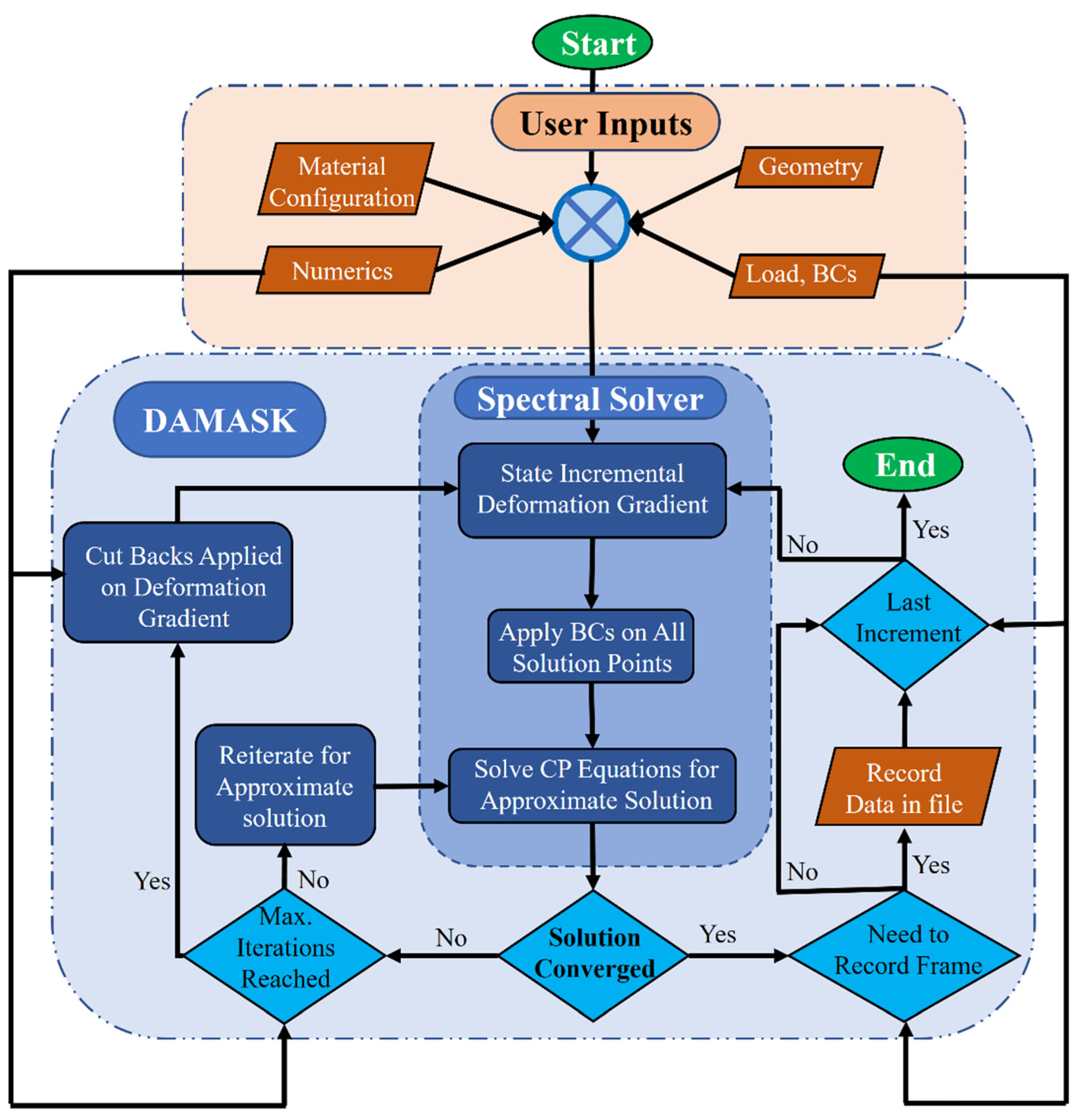
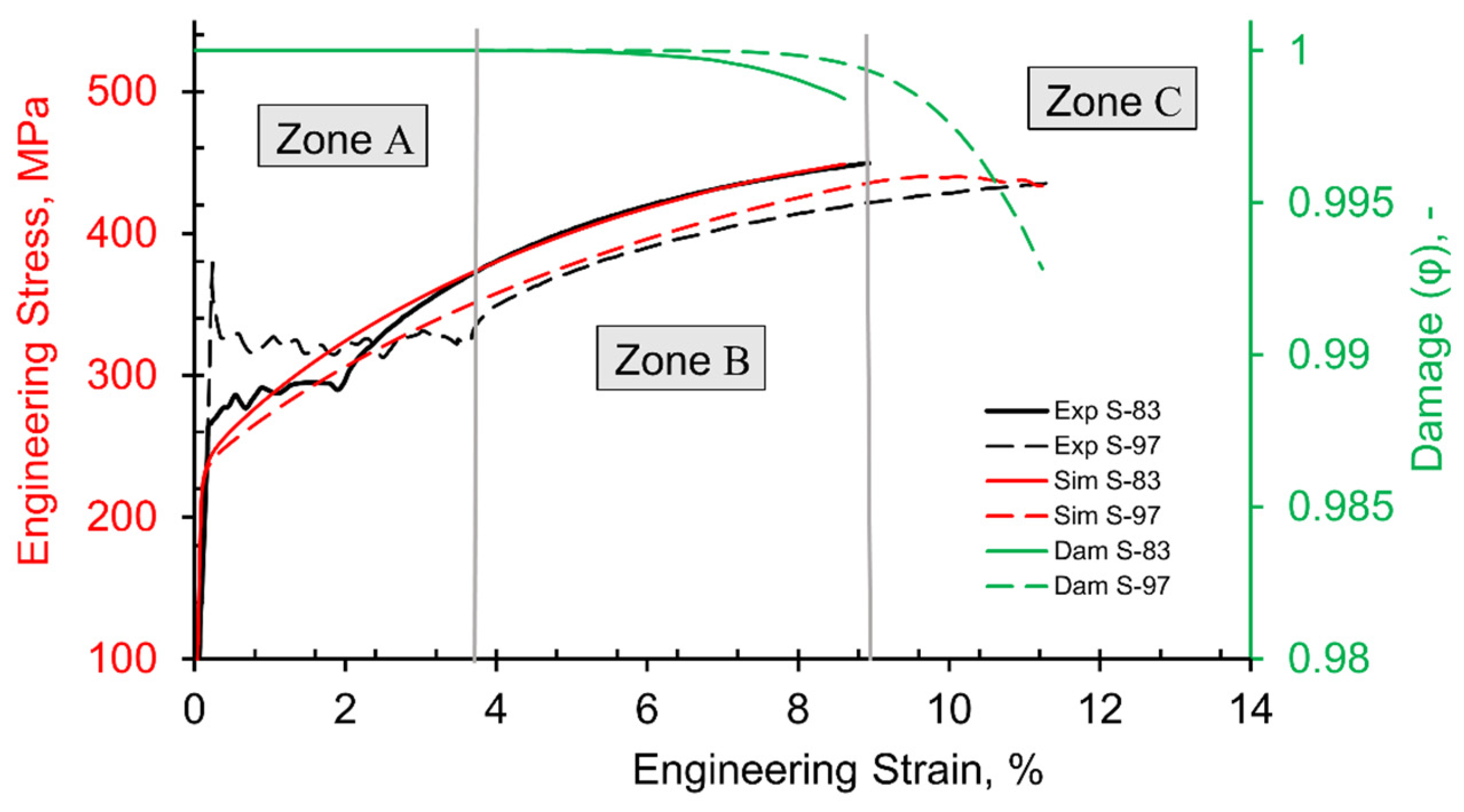
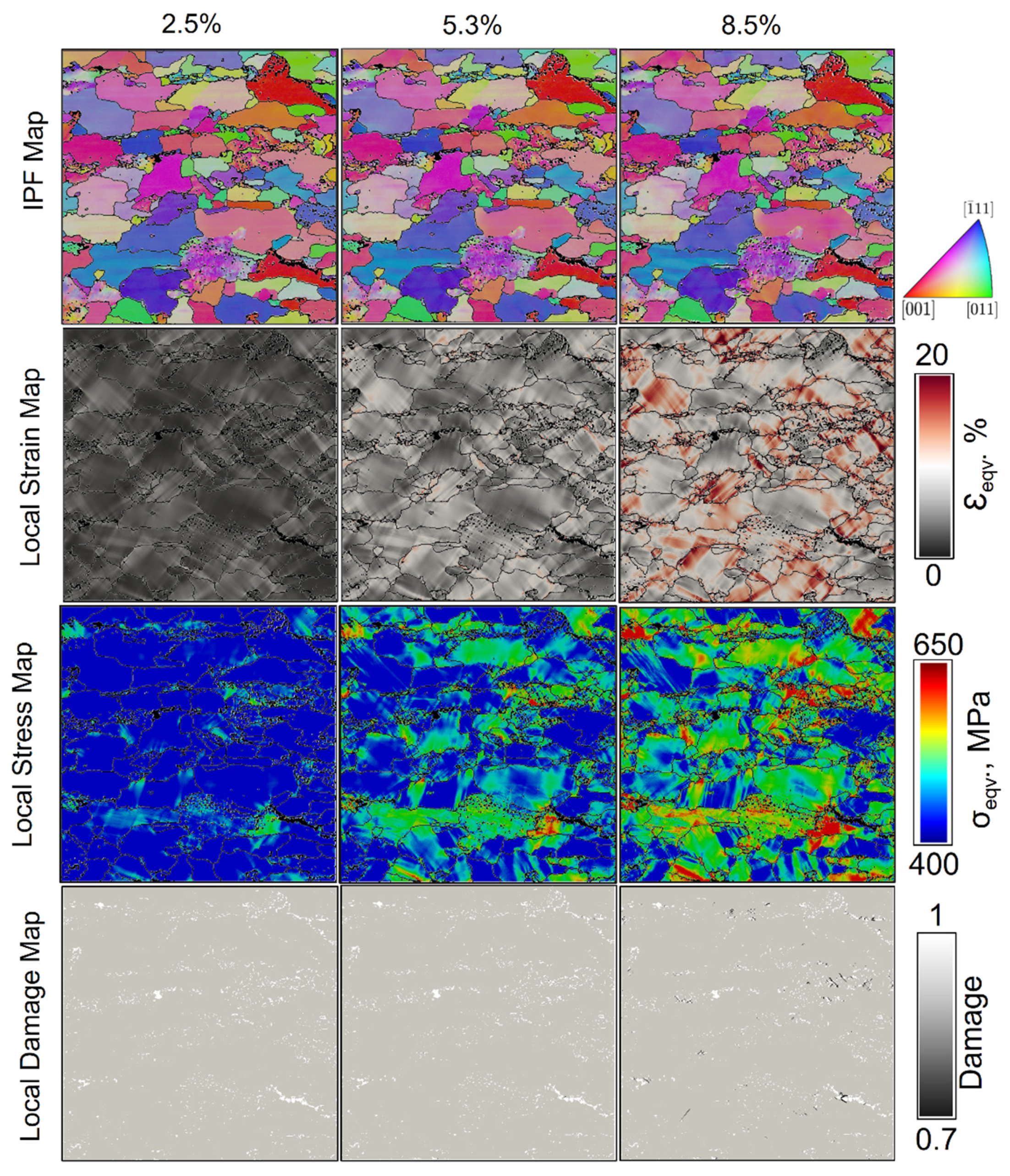
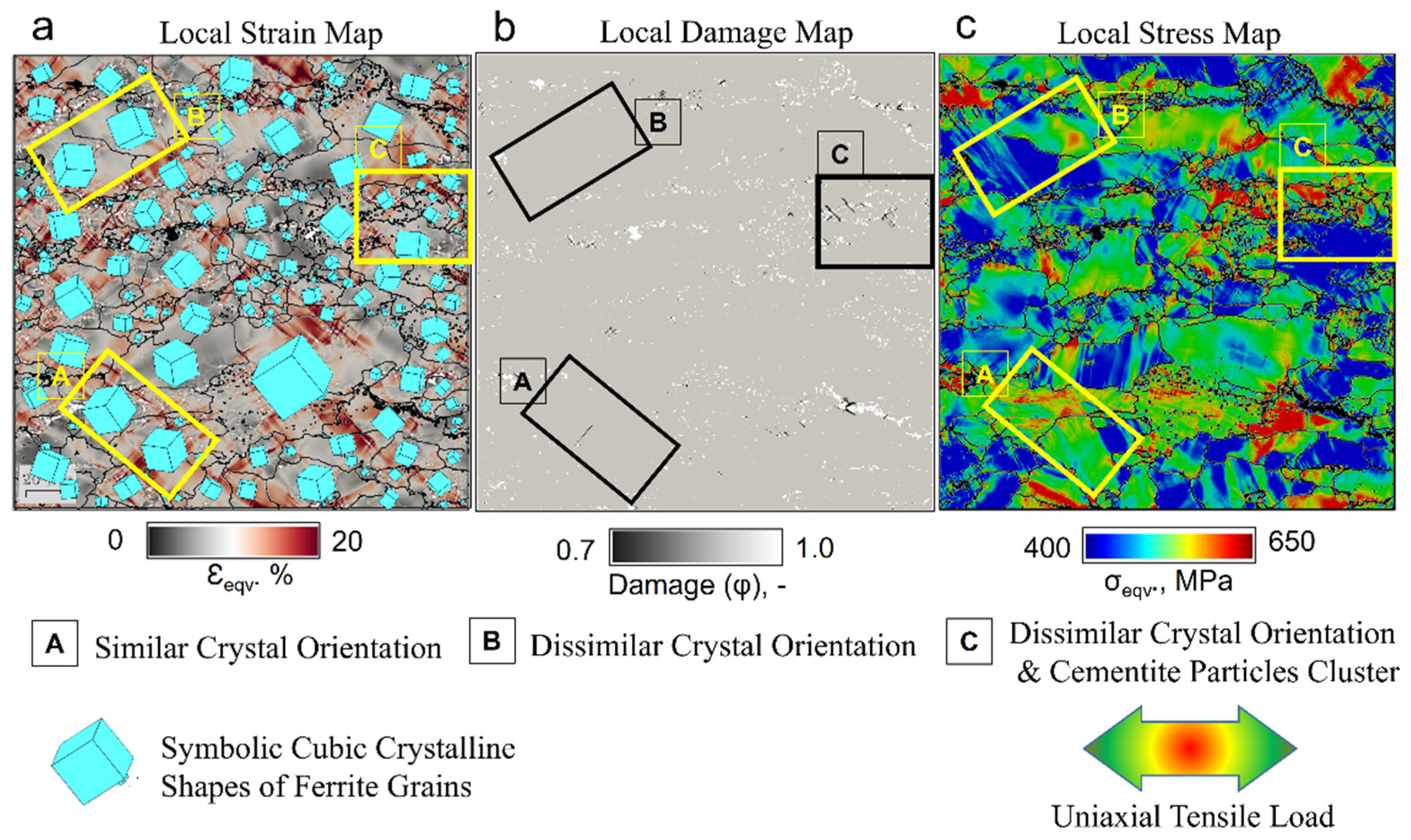
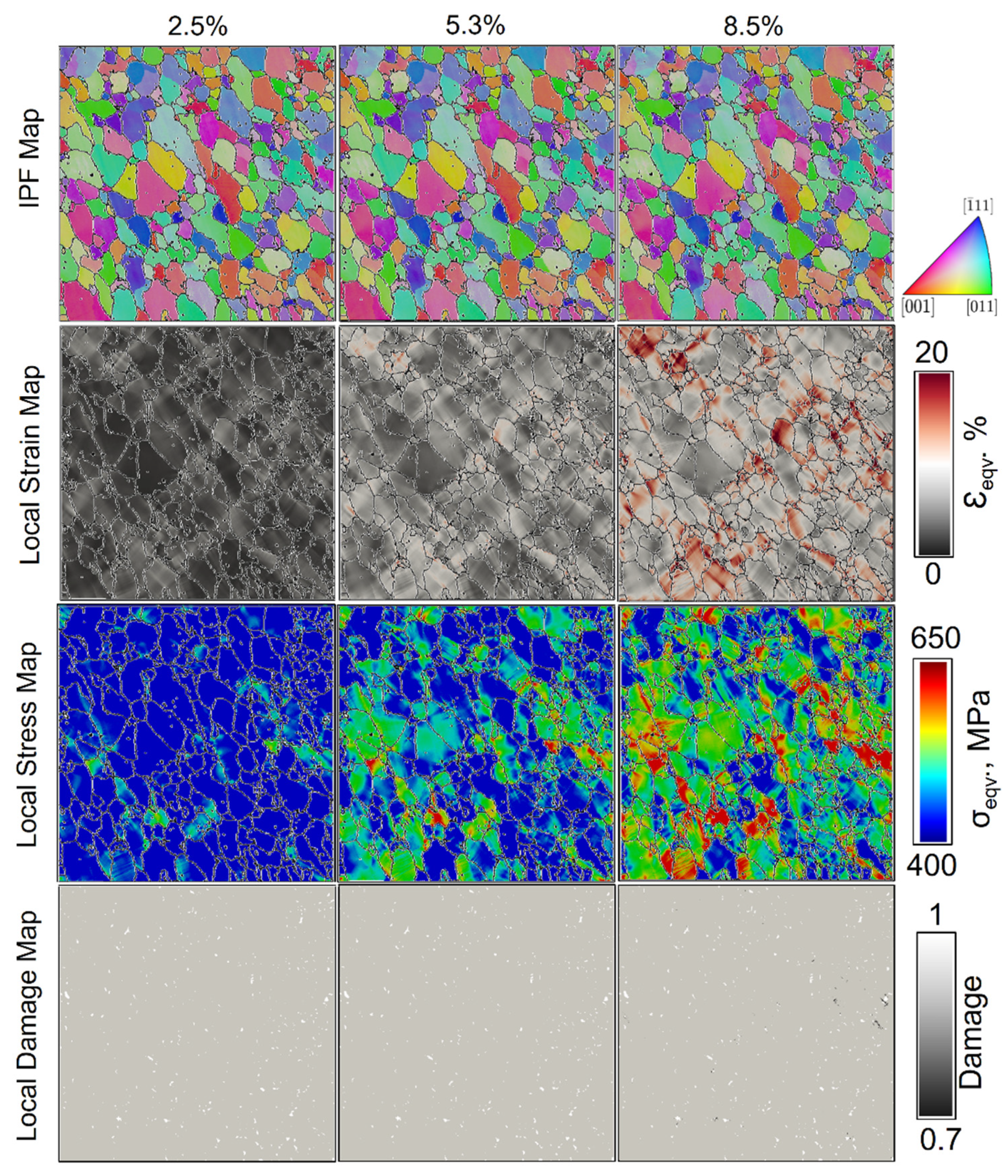
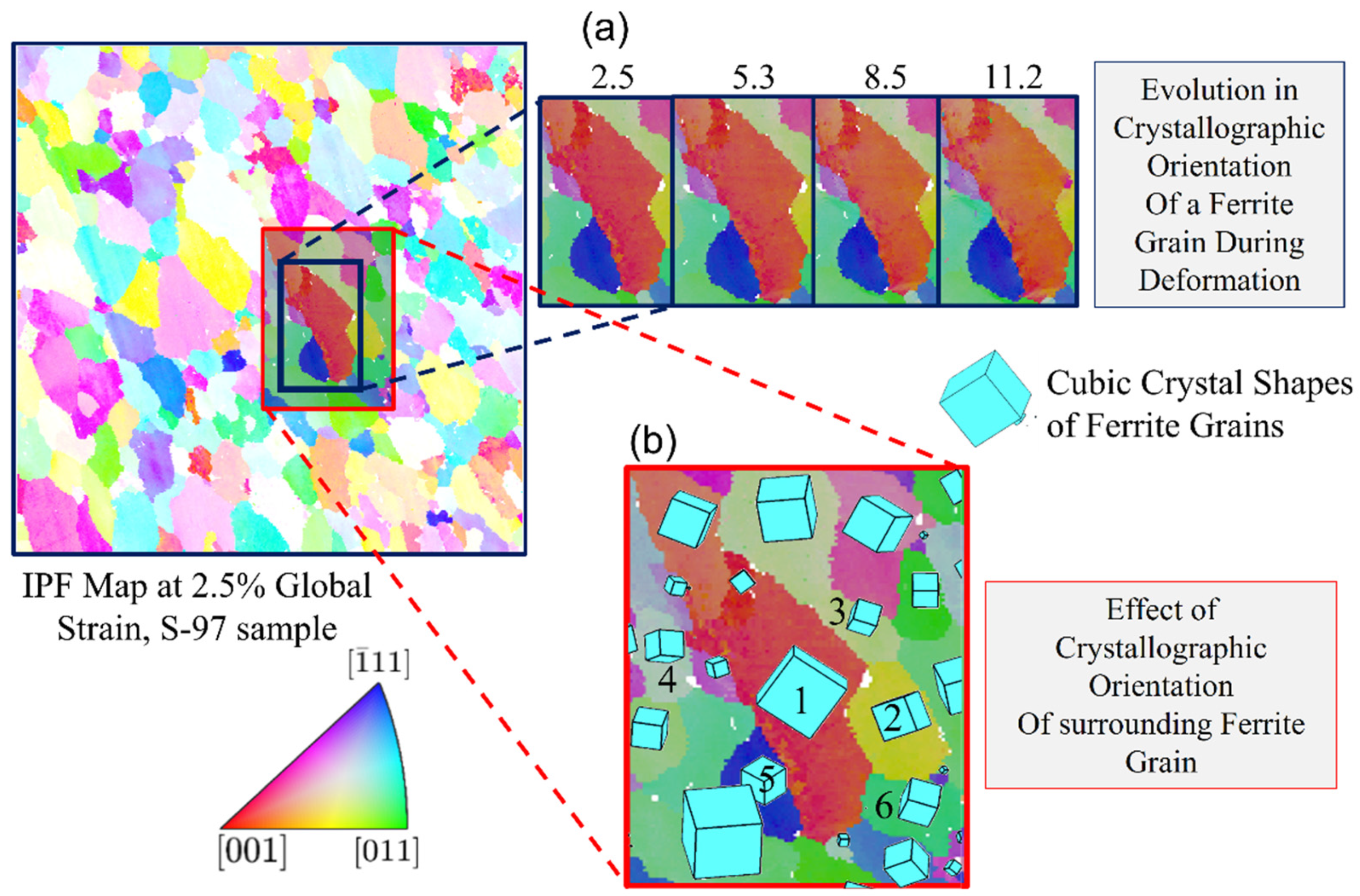
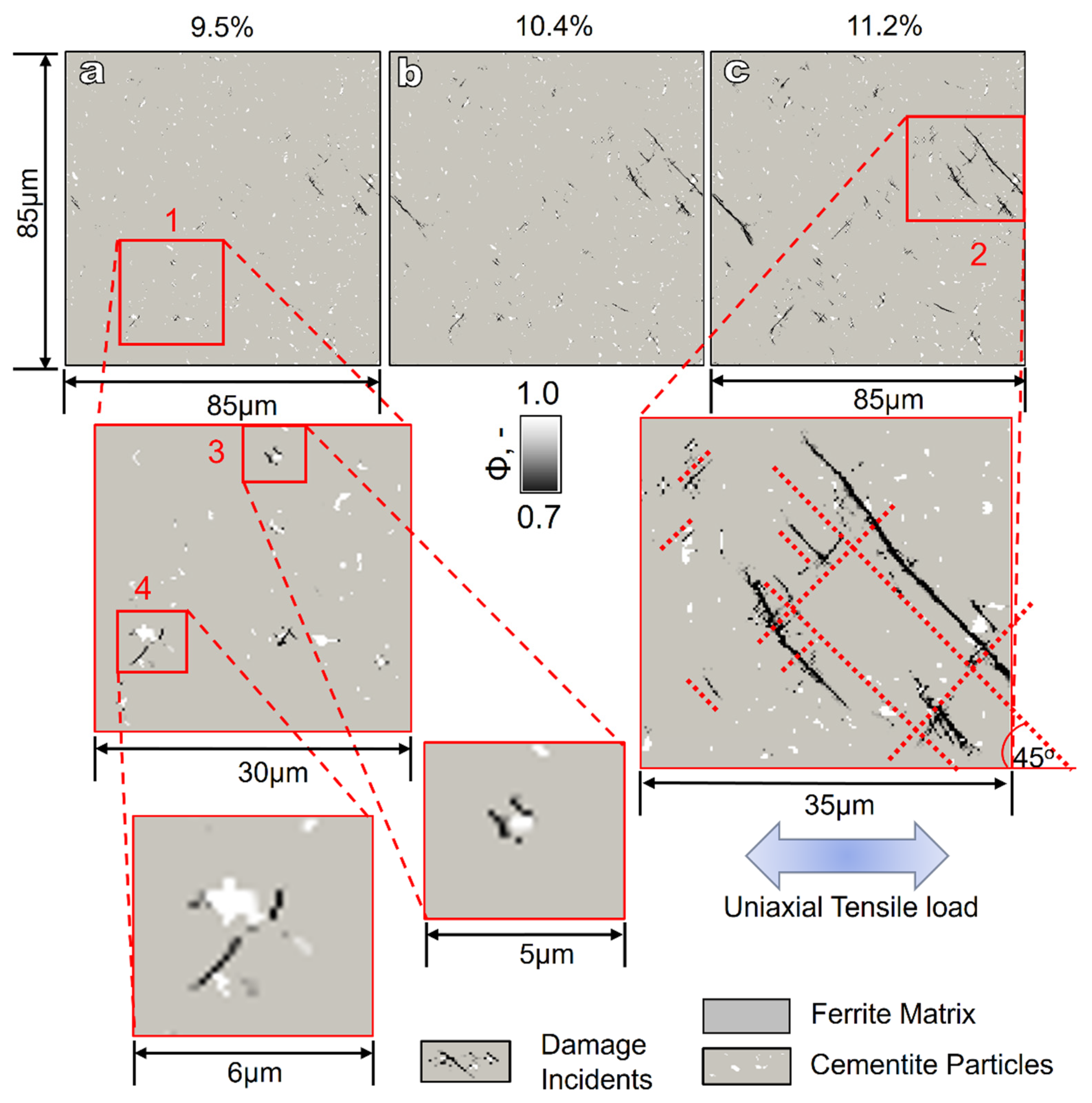
| Element | C | Si | Mn | P | S | Cr | Mo | Ni | Al | Cu |
|---|---|---|---|---|---|---|---|---|---|---|
| Percentage | 0.44 | 0.10 | 0.75 | 0.007 | 0.017 | 0.04 | 0.011 | 0.04 | 0.03 | 0.03 |
| Sample Case | Spheroidization Degree, % | Mean Ferrite Equivalent Diameter, µm | Max Ferrite Equivalent Diameter, µm | Global Strain at Damage Initiation, % |
|---|---|---|---|---|
| S-83 | 83 | 15.03 | 69.86 | 3.78 |
| S-97 | 97 | 11.96 | 38.43 | 5.69 |
| Elastic and Plastic Phase Parameters [8] | ||
|---|---|---|
| Parameter Description | Values for Ferrite | Unit |
| C11, C12, C44 | 233.3, 235.5, 128.0 | GPa |
| C11, C12, C44 (Cementite) | 375.0, 161.0, 130.0 | GPa |
| 0 | 5.6 × 10−4 | ms−1 |
| S0[111], [111] | 95, 222 | MPa |
| S0[112], [112] | 96, 412 | MPa |
| ho, hαβ | 1, 1 | GPa |
| n, w | 3, 2.0 | - |
| Nslip | 12, 12 | - |
| Ntwin | 0 | - |
| Ductile Damage Parameters [25] | ||
| Interface Energy (g0) | 1.0 | Jm−2 |
| Damage mobility coefficient (M) | 0.001 | s−1 |
| Critical plastic strain (εcrit) | 0.5 | - |
| Damage rate sensitivity coefficient (P) | 10 | - |
| Damage diffusion (D) | 1.0 | - |
| Damage type | Local | - |
Publisher’s Note: MDPI stays neutral with regard to jurisdictional claims in published maps and institutional affiliations. |
© 2021 by the authors. Licensee MDPI, Basel, Switzerland. This article is an open access article distributed under the terms and conditions of the Creative Commons Attribution (CC BY) license (https://creativecommons.org/licenses/by/4.0/).
Share and Cite
Umar, M.; Qayyum, F.; Farooq, M.U.; Guk, S.; Prahl, U. Qualitative Investigation of Damage Initiation at Meso-Scale in Spheroidized C45EC Steels by Using Crystal Plasticity-Based Numerical Simulations. J. Compos. Sci. 2021, 5, 222. https://doi.org/10.3390/jcs5080222
Umar M, Qayyum F, Farooq MU, Guk S, Prahl U. Qualitative Investigation of Damage Initiation at Meso-Scale in Spheroidized C45EC Steels by Using Crystal Plasticity-Based Numerical Simulations. Journal of Composites Science. 2021; 5(8):222. https://doi.org/10.3390/jcs5080222
Chicago/Turabian StyleUmar, Muhammad, Faisal Qayyum, Muhammad Umer Farooq, Sergey Guk, and Ulrich Prahl. 2021. "Qualitative Investigation of Damage Initiation at Meso-Scale in Spheroidized C45EC Steels by Using Crystal Plasticity-Based Numerical Simulations" Journal of Composites Science 5, no. 8: 222. https://doi.org/10.3390/jcs5080222
APA StyleUmar, M., Qayyum, F., Farooq, M. U., Guk, S., & Prahl, U. (2021). Qualitative Investigation of Damage Initiation at Meso-Scale in Spheroidized C45EC Steels by Using Crystal Plasticity-Based Numerical Simulations. Journal of Composites Science, 5(8), 222. https://doi.org/10.3390/jcs5080222











